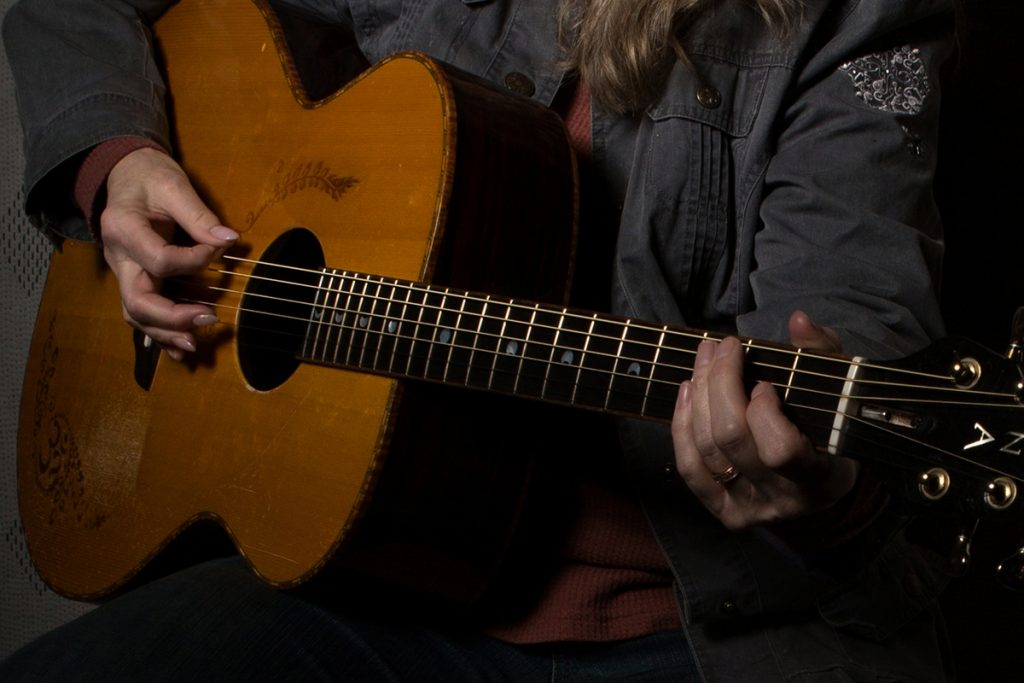There’s a point where your acoustic guitar parts all start to sound the same, and feel somewhat bland. It’s at this time where it’s most important to look somewhere new for inspiration, and that’s what Vicki Genfan aims to give you with her Acoustic Rhythm Guitar Cookbook. In the course, Vicki take you through several different types of progressions, adding in embellishments, picking patterns, and different techniques that will make your rhythm parts lively and interesting.
Let’s take a look at a sample of the course and work through a few of the progressions:
ii V I IV Progression: Key of G – Overview
Listen to what this progression might sound like with the “basic” chord shapes and a very basic strum. In the first study, we’ll add color tones and a new strumming pattern, and in the second study we’ll add a bit more syncopation to the strumming pattern.
Add Color Tones – Performance
Download the tab and notation for this acoustic rhythm guitar lesson on TrueFire.
Can you tell which beat the accent is on? How do the color tones change the feeling of this progression? Does it seem more interesting to you?
Add Syncopated Strums – Performance
Download the tab and notation for this acoustic rhythm guitar lesson on TrueFire.
Our second “accent” is now one 16th note earlier! Because it’s no longer on a down-beat, it adds a feeling of syncopation or a more complex rhythmic feel.
Add Syncopated Strums – Breakdown
Download the tab and notation for this acoustic rhythm guitar lesson on TrueFire.
Our first accent remains on the “1”. Our second accent comes on the “a” of the second beat. If it helps you to count out loud, or in your head, then do so. For some of you, it just works best to listen to what I’m playing and then copy it.
Open-D Tuning Piece: Key of D – Overview
Listen to the basic version in standard tuning. I think you’ll find that open D is a really fun tuning to add to your toolkit. The notes I tune to are these (starting with the 6th or lowest string): D A D F# A D.
For both studies, you’ll hear lot’s of color tones. In the first study, we’ll work with a fingerpicking style referred to as Travis picking (after Merle Travis), and in the 2nd study we’ll work with some harmonics.
Add a Travis Picking Pattern – Performance
Download the tab and notation for this acoustic rhythm guitar lesson on TrueFire.
Notice the full, deep sound that you’re able to get with this tuning. The chord shapes are quite simple but the sounds and voicings are beautiful. This is one reason I love open tunings so much!
Add a Travis Picking Pattern – Breakdown
Download the tab and notation for this acoustic rhythm guitar lesson on TrueFire.
Focus first on the picking pattern. Spend some time getting your fingers used to the pattern using the open D chord (yay, no left hand fingerings!). You may already know it, but if it’s new to you, the Travis picking pattern is extremely versatile and is used in many styles and genres of music. When learning the chords, remember to keep any fingers down that you can as you change chords.
Add Harmonics – Performance
Download the tab and notation for this acoustic rhythm guitar lesson on TrueFire.
We’re using the same Travis picking pattern, but placing harmonics at various spots in the study in order to bring a new sound and texture into the piece. Notice that sometimes I’m striking harmonics one at a time, and sometimes I’m playing a group of 2 or more together, like a chord.
Add Harmonics – Breakdown
Download the tab and notation for this acoustic rhythm guitar lesson on TrueFire.
You should have the picking pattern down at this point. Now…practice the harmonics! Make sure you get the touch and location right. You should be able to tell when you’ve got the right sound. Play the study slowly at first so you can keep the flow smooth. There’s a bit of extra movement required in order to jump up to the 12th fret or 7th fret to get the harmonics. You’ll need to think about that so you don’t lose the rhythmic flow of the piece.
There’s plenty more to chew on in the full version of the course, with an incredible amount of ideas for spicing up your rhythm playing. For each performance study introducing a new technique, Vicki will then break it down for you, and you’ll also get tab and notation to practice on your own. Check it out!
